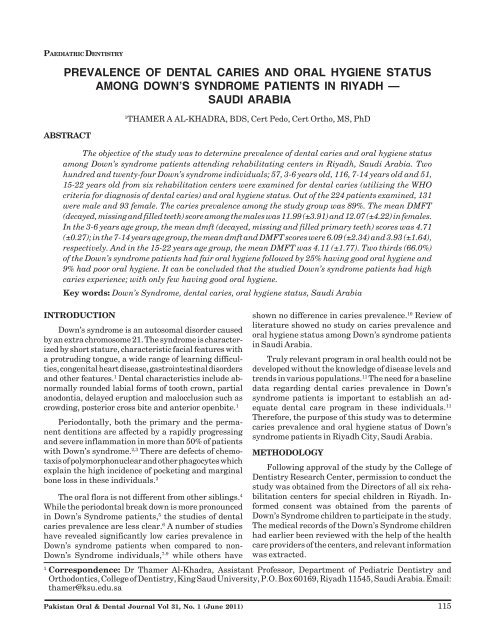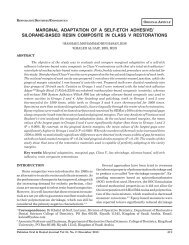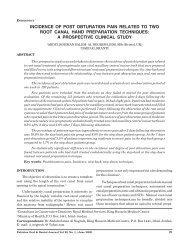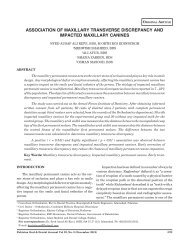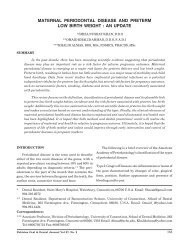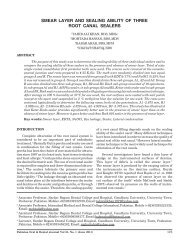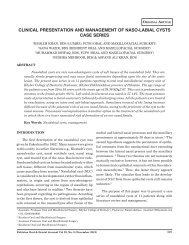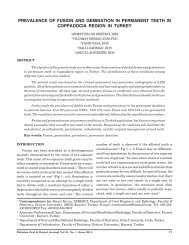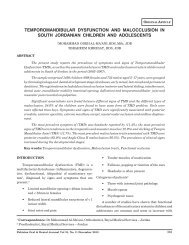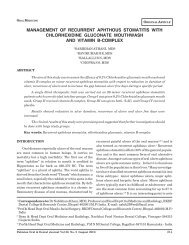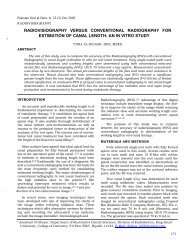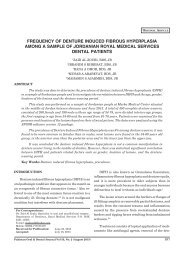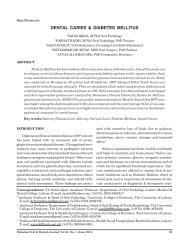prevalence of dental caries and oral hygiene status among down's ...
prevalence of dental caries and oral hygiene status among down's ...
prevalence of dental caries and oral hygiene status among down's ...
You also want an ePaper? Increase the reach of your titles
YUMPU automatically turns print PDFs into web optimized ePapers that Google loves.
Dental Caries in Down’s Syndrome patientsPAEDIATRIC DENTISTRYPREVALENCE OF DENTAL CARIES AND ORAL HYGIENE STATUSAMONG DOWN’S SYNDROME PATIENTS IN RIYADH —SAUDI ARABIAABSTRACT1THAMER A AL-KHADRA, BDS, Cert Pedo, Cert Ortho, MS, PhDThe objective <strong>of</strong> the study was to determine <strong>prevalence</strong> <strong>of</strong> <strong>dental</strong> <strong>caries</strong> <strong>and</strong> <strong>oral</strong> <strong>hygiene</strong> <strong>status</strong><strong>among</strong> Down’s syndrome patients attending rehabilitating centers in Riyadh, Saudi Arabia. Twohundred <strong>and</strong> twenty-four Down’s syndrome individuals; 57, 3-6 years old, 116, 7-14 years old <strong>and</strong> 51,15-22 years old from six rehabilitation centers were examined for <strong>dental</strong> <strong>caries</strong> (utilizing the WHOcriteria for diagnosis <strong>of</strong> <strong>dental</strong> <strong>caries</strong>) <strong>and</strong> <strong>oral</strong> <strong>hygiene</strong> <strong>status</strong>. Out <strong>of</strong> the 224 patients examined, 131were male <strong>and</strong> 93 female. The <strong>caries</strong> <strong>prevalence</strong> <strong>among</strong> the study group was 89%. The mean DMFT(decayed, missing <strong>and</strong> filled teeth) score <strong>among</strong> the males was 11.99 (±3.91) <strong>and</strong> 12.07 (±4.22) in females.In the 3-6 years age group, the mean dmft (decayed, missing <strong>and</strong> filled primary teeth) scores was 4.71(±0.27); in the 7-14 years age group, the mean dmft <strong>and</strong> DMFT scores were 6.09 (±2.34) <strong>and</strong> 3.93 (±1.64),respectively. And in the 15-22 years age group, the mean DMFT was 4.11 (±1.77). Two thirds (66.0%)<strong>of</strong> the Down’s syndrome patients had fair <strong>oral</strong> <strong>hygiene</strong> followed by 25% having good <strong>oral</strong> <strong>hygiene</strong> <strong>and</strong>9% had poor <strong>oral</strong> <strong>hygiene</strong>. It can be concluded that the studied Down’s syndrome patients had high<strong>caries</strong> experience; with only few having good <strong>oral</strong> <strong>hygiene</strong>.Key words: Down’s Syndrome, <strong>dental</strong> <strong>caries</strong>, <strong>oral</strong> <strong>hygiene</strong> <strong>status</strong>, Saudi ArabiaINTRODUCTIONDown’s syndrome is an autosomal disorder causedby an extra chromosome 21. The syndrome is characterizedby short stature, characteristic facial features witha protruding tongue, a wide range <strong>of</strong> learning difficulties,congenital heart disease, gastrointestinal disorders<strong>and</strong> other features. 1 Dental characteristics include abnormallyrounded labial forms <strong>of</strong> tooth crown, partialanodontia, delayed eruption <strong>and</strong> malocclusion such ascrowding, posterior cross bite <strong>and</strong> anterior openbite. 1Periodontally, both the primary <strong>and</strong> the permanentdentitions are affected by a rapidly progressing<strong>and</strong> severe inflammation in more than 50% <strong>of</strong> patientswith Down’s syndrome. 2,3 There are defects <strong>of</strong> chemotaxis<strong>of</strong> polymorphonuclear <strong>and</strong> other phagocytes whichexplain the high incidence <strong>of</strong> pocketing <strong>and</strong> marginalbone loss in these individuals. 3The <strong>oral</strong> flora is not different from other siblings. 4While the periodontal break down is more pronouncedin Down’s Syndrome patients, 5 the studies <strong>of</strong> <strong>dental</strong><strong>caries</strong> <strong>prevalence</strong> are less clear. 6 A number <strong>of</strong> studieshave revealed significantly low <strong>caries</strong> <strong>prevalence</strong> inDown’s syndrome patients when compared to non-Down’s Syndrome individuals, 7-9 while others haveshown no difference in <strong>caries</strong> <strong>prevalence</strong>. 10 Review <strong>of</strong>literature showed no study on <strong>caries</strong> <strong>prevalence</strong> <strong>and</strong><strong>oral</strong> <strong>hygiene</strong> <strong>status</strong> <strong>among</strong> Down’s syndrome patientsin Saudi Arabia.Truly relevant program in <strong>oral</strong> health could not bedeveloped without the knowledge <strong>of</strong> disease levels <strong>and</strong>trends in various populations. 11 The need for a baselinedata regarding <strong>dental</strong> <strong>caries</strong> <strong>prevalence</strong> in Down’ssyndrome patients is important to establish an adequate<strong>dental</strong> care program in these individuals. 11Therefore, the purpose <strong>of</strong> this study was to determine<strong>caries</strong> <strong>prevalence</strong> <strong>and</strong> <strong>oral</strong> <strong>hygiene</strong> <strong>status</strong> <strong>of</strong> Down’ssyndrome patients in Riyadh City, Saudi Arabia.METHODOLOGYFollowing approval <strong>of</strong> the study by the College <strong>of</strong>Dentistry Research Center, permission to conduct thestudy was obtained from the Directors <strong>of</strong> all six rehabilitationcenters for special children in Riyadh. Informedconsent was obtained from the parents <strong>of</strong>Down’s Syndrome children to participate in the study.The medical records <strong>of</strong> the Down’s Syndrome childrenhad earlier been reviewed with the help <strong>of</strong> the healthcare providers <strong>of</strong> the centers, <strong>and</strong> relevant informationwas extracted.1Correspondence: Dr Thamer Al-Khadra, Assistant Pr<strong>of</strong>essor, Department <strong>of</strong> Pediatric Dentistry <strong>and</strong>Orthodontics, College <strong>of</strong> Dentistry, King Saud University, P.O. Box 60169, Riyadh 11545, Saudi Arabia. Email:thamer@ksu.edu.saPakistan Oral & Dental Journal Vol 31, No. 1 (June 2011)115
Dental Caries in Down’s Syndrome patientsOne examiner who was trained <strong>and</strong> calibrated by asenior faculty member <strong>of</strong> the College <strong>of</strong> Dentistry, KingSaud University, carried out all the examinations. TheWHO criteria 12 were utilized for diagnosis <strong>of</strong> <strong>dental</strong><strong>caries</strong>. Each child was examined while seated on aportable chair under natural light using a disposablemirror <strong>and</strong> tongue blade. An explorer was sparinglyused on doubtful surfaces. In case <strong>of</strong> doubt, thetooth was marked as sound. No radiographs weretaken.The <strong>oral</strong> <strong>hygiene</strong> <strong>status</strong> was recorded as good,fair or poor using the index <strong>of</strong> James et al. 13 The datawere entered into a computer <strong>and</strong> analyzed usingSPSS (V. 10) to generate descriptive statistics for eachvariable.RESULTSA total <strong>of</strong> 224 Down syndrome patients (131 male<strong>and</strong> 93 female) were examined. Their ages ranged from3-22 years. Upon examination <strong>of</strong> the medical records,it was revealed that 30 <strong>of</strong> them had history <strong>of</strong> cardiacsurgery, 38 had history <strong>of</strong> mild asthma, 10 hypothyroidism<strong>and</strong> 18 had other medical conditions such asepilepsy, allergies, diabetes mellitus; 128 reported nomedical conditions.The <strong>caries</strong> <strong>prevalence</strong> in the group was 89%. Themean decayed, missing <strong>and</strong> filled teeth scores were11.99 ± 3.91 <strong>and</strong> 12.07 ± 4.22 in males <strong>and</strong> femalesrespectively (Table I). Even though the mean <strong>caries</strong>scores were slightly high <strong>among</strong> the females; thedifference was not statistically significant.The patients were further divided into three agegroups i.e., 3–6 years, 7-14 years <strong>and</strong> 15-21 years. Themean dmft score in 3-6 years-olds was 4.71 ± 1.27. Inthe 7-14 years olds, the mean dmft <strong>and</strong> DMFT scoreswere 6.09 ± 2.34 <strong>and</strong> 3.93 ± 1.64, respectively.The corresponding figures in the 15-22 years-oldswere 1.53 ± 0.54 <strong>and</strong> 4.11 ± 1.77. The decay componentwas observed to be the major constituent <strong>of</strong> the decayed,missing <strong>and</strong> filled teeth scores (Tables 2 <strong>and</strong> 3).TABLE 1: CARIES EXPERIENCE OF DOWN’SSYNDROME PATIENTS BY GENDERMale (131) Female (93 ) Total (224)Mean±SD Mean±SD Mean±SDDecay 7.51 ± 3.12 8.41 ± 4.32 7.96 ± 3.72Missing 3.87 ± 1.21 4.04 ± 1.45 3.95 ± 1.33Filled 10.61 ± 4.42 10.22 ± 4.12 10.42 ± 4.27DMFT 11.99 ± 3.91 12.07 ± 4.22 12.03 ± 4.07(primary+permanent)Pakistan Oral & Dental Journal Vol 31, No. 1 (June 2011)TABLE 4: ORAL HYGIENE STATUS OF THEDOWN’S SYNDROME PATIENTSClassification Frequency Percent %Good Oral Hygiene 19 9 %Fair Oral Hygiene 148 66 %Poor Oral Hygiene 57 25 %Table 4 summarizes the <strong>oral</strong> <strong>hygiene</strong> <strong>status</strong> <strong>among</strong>the study group. The majority (66%) had fair <strong>oral</strong><strong>hygiene</strong> <strong>status</strong>, while 25% had poor <strong>oral</strong> <strong>hygiene</strong> withonly 9% having good <strong>oral</strong> <strong>hygiene</strong>.DISCUSSIONTABLE 2: CARIES EXPERIENCE BYAGE-GROUPS3 to 6 7 to 14 15 to 22years years years(n=57) (n=16) (n=51)Mean±SD Mean±SD Mean±SDDecay 3.61 ± 1.23 3.66 ± 1.42 0.61 ± 0.21Missing 0.93 ± 0.021 2.14 ± 0.91 0.78 ± 0.31Filled 0.17 ± 0.02 0.29 ± 0.01 0.14 ± 0.02DMFT 4.71 ± 1.27 6.09 ± 2.34 1.53 ± 0.54(primary+permanent)TABLE 3: CARIES EXPERIENCE (DMFT)BY AGE-GROUP7 – 14 yrs 15 - 22 yrs(n = 16) (n = 51)Mean ± SD Mean ± SDDecay 1.12 ± 0.61 3.59 ± 1.22Missing 2.59 ± 1.01 0.19 ± 0.54Filled 0.22 ± 0.02 0.33 ± 0.01DMFT 3.93 ± 1.64 4.11 ± 1.77Down syndrome, a congenital autosomal anomalyalso called trisomy 21, is a genetic alteration characterizedby generalized growth <strong>and</strong> mental deficiency.Down syndrome patients have characteristic or<strong>of</strong>acialfeatures. Some <strong>of</strong> the common <strong>oral</strong> findings in thesechildren include open bite, macroglossia, fissured lips<strong>and</strong> tongue, delayed eruption <strong>of</strong> teeth, missing <strong>and</strong>malformed teeth, microdontia, crowding, malocclusion,bruxism, poor <strong>oral</strong> <strong>hygiene</strong> <strong>and</strong> a low <strong>caries</strong>experience. 14-16Low <strong>caries</strong> experience has been reported in Down’ssyndrome children in many countries. 17-19 A number <strong>of</strong>studies on <strong>oral</strong> health <strong>status</strong> <strong>of</strong> healthy Saudi children116
Dental Caries in Down’s Syndrome patientshave shown a high <strong>caries</strong> <strong>prevalence</strong> in Riyadh. 20,24 Thepresent study also revealed a high <strong>caries</strong> <strong>prevalence</strong><strong>and</strong> severity <strong>among</strong> the Down syndrome patients inRiyadh. This is not in agreement with studies onDown’s syndrome patient in other countries that showeda low <strong>caries</strong> <strong>prevalence</strong> as well as a high number <strong>of</strong><strong>caries</strong> free Down’s syndrome patients. 5,25,26 The low<strong>caries</strong> <strong>prevalence</strong> in Down syndrome children appearsto be due to immune protection caused by the elevatedsalivary S. mutans specific IgA concentrations <strong>and</strong> asimpler occlusal morphology. 27 However, it seemsas sub-optimal <strong>oral</strong> <strong>hygiene</strong> <strong>status</strong> <strong>among</strong> the studypopulation has neutralized the above stated advantages.Oral <strong>hygiene</strong> plays an important role in the initiation<strong>and</strong> progression <strong>of</strong> <strong>dental</strong> <strong>caries</strong> <strong>and</strong> periodontaldiseases. 28,29 In the present study majority <strong>of</strong> the patientshad fair to poor <strong>oral</strong> <strong>hygiene</strong>. This could beattributed to their reduced manual dexterity <strong>and</strong> lack<strong>of</strong> <strong>oral</strong> health education in these individuals <strong>and</strong> theircare-takers.The present study has provided baseline data regarding<strong>caries</strong> <strong>prevalence</strong> <strong>and</strong> <strong>oral</strong> <strong>hygiene</strong> <strong>status</strong> inDown’s syndrome patients <strong>of</strong> Riyadh. It is expected thatthe results <strong>of</strong> this study would help in planning <strong>of</strong>restorative <strong>and</strong> preventive <strong>dental</strong> care, especially <strong>oral</strong>health education <strong>of</strong> Down’s syndrome individuals <strong>and</strong>their care-takers.CONCLUSIONS• The <strong>caries</strong> <strong>prevalence</strong> <strong>and</strong> severity was very high<strong>among</strong> Down’s syndrome patients in Riyadh.• There was no statistically significant difference in<strong>caries</strong> experience between male <strong>and</strong> female Down’ssyndrome patients.• Majority <strong>of</strong> the Down’s syndrome patients had fair<strong>oral</strong> <strong>hygiene</strong>.AcknowledgementThe author wishes to thank Drs M Alqhatani, NAlrashidi, <strong>and</strong> A. Almudaibari for their valuable contributionin the field work.REFERENCES1 Hall RK. Pediatric Or<strong>of</strong>acial Medical Pathology. London:Chapman & Hall Medical Co. 1994.2 Svatun B, Gjermo P. Oral <strong>hygiene</strong>, periodontal health <strong>and</strong>need for periodontal treatment <strong>among</strong> institutionalized mentallysubnormal persons in Norway. Acta Odontol Sc<strong>and</strong>1978;36:89-95.3 Sznajder N, Carraro J, Otero E, Carranza Jr F. Clinicalperiodontal findings in trisomy 21 (mongolism). J PeriodontalRes 1968;3:1-5.4 Orner G. Post-eruptive tooth age in children with Down’ssyndrome <strong>and</strong> their sibs. J Dent Res 1975;54:581-87.Pakistan Oral & Dental Journal Vol 31, No. 1 (June 2011)5 Brown RH, Cunningham WM. Some <strong>dental</strong> manifestations<strong>of</strong> mongolism. Oral Surg Oral Med Oral Pathol 1961;14:664-76.6 Latner LE. The <strong>caries</strong> experience in three genotypes <strong>of</strong>Down’s syndrome. J Pedod 1983;7:83-90.7 Wolf WC. Caries incidence in Down’s Syndrome (mongolism).J Wis State Dent Soc 1967;43:3-7.8 Orner G. Dental <strong>caries</strong> experience <strong>among</strong> children with Down’ssyndrome <strong>and</strong> their sibs. Arch Oral Biol 1975;20:627-34.9 Steinberg AD, Zimmerman S. The Lincoln <strong>dental</strong> <strong>caries</strong> study:a three-year evaluation <strong>of</strong> <strong>dental</strong> <strong>caries</strong> in persons withvarious mental disorders. J Am Dent Assoc 1978;97:981-84.10 Cutress TW. Dental <strong>caries</strong> in trisomy 21. Arch Oral Biol1971;16:1329-44.11 Barmes DE. Indicators for <strong>oral</strong> health <strong>and</strong> their implicationsfor developing countries. Int Dent J 1983;33:60-66.12 WHO. Oral health surveys: Basic methods. Geneva: WorldHealth Organization 1997.13 James P, Jackson D, Slack G, Lawton F. Gingival health <strong>and</strong><strong>dental</strong> cleanliness in English schoolchildren. Arch Oral Biol1960;3:57-66.14 Borea G, Magi M, Mingarelli R, Zamboni C. The <strong>oral</strong> cavity inDown syndrome. J Pedod 1990;14:139-40.15 Cheng RH, Leung WK, Corbet EF, King NM. Oral health<strong>status</strong> <strong>of</strong> adults with Down syndrome in Hong Kong. SpecCare Dentist 2007;27:134-38.16 Chan AR. Dental <strong>caries</strong> <strong>and</strong> periodontal disease in Down’ssyndrome patients. Univ Tor Dent J 1994;7:18-21.17 Stabholz A, Mann J, Sela M, Schurr D, Steinberg D, ShapiraJ. Caries experience, periodontal treatment needs, salivarypH, <strong>and</strong> Streptococcus mutans counts in a preadolescent Downsyndrome population. Spec Care Dentist 1991;11:203-08.18 Johnson N, Young M. Periodontal disease in mongols. JPeriodontol 1963;34:41-47.19 Morinushi T, Lopatin DE, Tanaka H. The relationship between<strong>dental</strong> <strong>caries</strong> in the primary dentition <strong>and</strong> anti S.mutans serum antibodies in children with Down’s syndrome.J Clin Pediatr Dent 1995;19:279-84.20 Wyne A, Darwish S, Adenubi J, Battata S, Khan N. The<strong>prevalence</strong> <strong>and</strong> pattern <strong>of</strong> nursing <strong>caries</strong> in Saudi preschoolchildren. Int J Paediatr Dent 2001;11:361-64.21 Al Dosari A, Abdellatif H, Al-Refai A. Oral health <strong>status</strong> <strong>of</strong>primary dentition <strong>among</strong> 551 children aged 6-8 years in Jazan,Saudi Arabia. Saudi Dent J 2000;12:67-71.22 Khan NB, Al Ghannam NA, Al Shammery AR, Wyne AH.Caries in primary school children: Prevalence, severity <strong>and</strong>pattern in Al-Ahsa, Saudi Arabia. Saudi Dent J 2000;13:71-74.23 AlDosari A, Wyne A, Akpata E, Khan N. Caries <strong>prevalence</strong> <strong>and</strong>its relation to water fluoride levels <strong>among</strong> schoolchildren inCentral Province <strong>of</strong> Saudi Arabia. Int Dent J 2004;54:424-28.24 Wyne AH, Al-Ghorabi BM, Al-Asiri YA, Khan NB. Caries<strong>prevalence</strong> in Saudi primary schoolchildren <strong>of</strong> Riyadh <strong>and</strong>their teachers’ <strong>oral</strong> health knowledge, attitude <strong>and</strong> practices.Saudi Med J 2002;23:77-81.25 Winer R, Cohen M. Dental <strong>caries</strong> in mongolism. Dental Progr1962;2:217-19.26 Johnson N, Young MA, Gallios JA. Dental <strong>caries</strong> experience<strong>of</strong> mongoloid children. J Dent Child 1960;27:292-94.27 Lee SR, Kwon HK, Song KB, Choi YH. Dental <strong>caries</strong> <strong>and</strong>salivary immunoglobulin A in Down syndrome children. JPaediatr Child Health 2004;40:530-33.28 Sheiham A, Watt RG. The common risk factor approach: arational basis for promoting <strong>oral</strong> health. Community DentOral Epidemiol 2000;28:399-406.29 Watt RG. Emerging theories into the social determinants <strong>of</strong>health: implications for <strong>oral</strong> health promotion. CommunityDent Oral Epidemiol 2002;30:241-47.117


